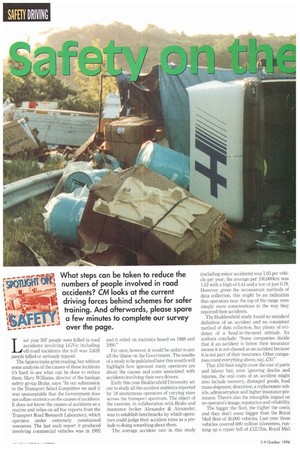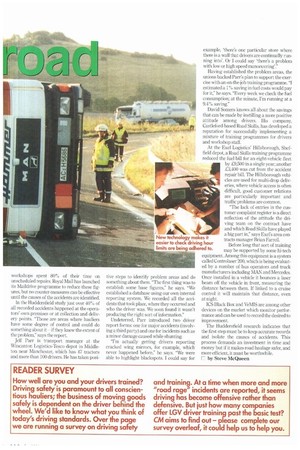L ast year 597 people were killed in road accidents involving
Page 42

Page 43

If you've noticed an error in this article please click here to report it so we can fix it.
LGVs; including off-road incidents the toll was 3,628 people killed or seriously injured.
The figures make grim reading, but without some analysis of the causes of these incidents it hard to see what can be done to reduce them. Mary Williams, director of the haulage safety group Brake, says: "In our submission to the Transport Select Committee we said it was unacceptable that the Government does not collate statistk.s on the muses of accidents. It does not know the causes of accidents as a routine and relies on ad hoc reports from the Transport Road Research Laboratory, which operates under extremely constrained resources. The last such report it produced involving commercial vehicles was in 1992 and it relied on statistics based on 1988 and 1990."
For once, however, it would be unfair to put all the blame on the Government. The results of a study to be published later this month will highlight how ignorant many operators are about the causes and costs associated with accidents involving their own drivers.
Early this year Huddersfield University set out to study all the accident statistics reported by 18 anonymous operators of varying sizes across the transport spectrum. The object of the exercise, in collaboration with Brake and insurance broker Alexander & Alexander, was to establish benchmarks by which operators could judge their accident rates as a prelude to doing something about them.
The average accident rate in this study (including minor accidents) was 1,03 per vehicle per year; the average per 100,000km was 1.52 with a high of 6.44 and a low of just 0.19. However, given the inconsistent methods of data collection, this might be an indication that operators near the top of the range were simply more conscientious in the way they reported their accidents.
The Huddersfield study found no standard definition of an accident and no consistent method of data collection, but plenty of evidence of a head-in-the-sand attitude. Its authors conclude: "Some companies decide that if an accident is below their insurance excess it is not classed as an accident because it is not part of their insurance. Other companies count everything above, say, £50."
That £50 limit might cover the cost of parts and labour but, even ignoring deaths and injuries, the real costs of an accident might also include recovery, damaged goods, load trans-shipment, downtime, a replacement vehicle, administration and higher insurance premiums. There's also the intangible impact on an operator's image, reputation and reliability The bigger the fleet, the higher the costs; and they don't come bigger than the Royal Mail fleet of 30,000 vehicles. Last year those vehicles covered 690 million kilometres, running up a repair bill of £12.75m. Royal Mail workshops spent 80% of their time on unscheduled repairs, Royal Mail has launched its Maildrive programme to reduce these figures, but no counter-measures can be effective until the causes of the accidents are identified.
In the Huddersfield study just over 40% of all recorded accidents happened at the operators' own premises or at collection and delivery points. "Those are areas where hauliers have some degree of control and could do something about it if they knew the extent of the problem," says the report.
Jeff Parr is transport manager at the Wincanton Logistics-Tesco depot in Middleton near Manchester, which has 47 tractors and more than 100 drivers. He has taken posi
tive steps to identify problem areas and do something about them. "The first thing was to establish some base figures," he says. "We established a database using our own internal reporting system. We recorded all the accidents that took place, where they occurred and who the driver was. We soon found it wasn't producing the right sort of information."
Undeterred, Parr introduced two driver report forms: one for major accidents (involving a third party) and one for incidents such as a minor damage caused while shunting.
"I'm actually getting drivers reporting cracked wing mirrors, for example, which never happened before," he says. "We were able to highlight hlackspots. I could say for example, 'there's one particular store where there is a wall that drivers are continually running into'. Or I could say `there's a problem with low or high speed manoeuvring'," Having established the problem areas, the unions backed Parr's plan to support the exercise with an on-the-job training programme. "I estimated a 1% saving in fuel costs would pay for it," he says. "Every week we check the fuel consumption; at the minute, I'm running at a 9.4% saving," David Somers knows all about the savings that can be made by instilling a more positive attitude among drivers, his company, Castleford-based Road Skills, has developed a reputation for successfully implementing a mixture of training programmes for drivers and workshop staff.
At the Exel Logistics' Hillsborough, Sheffield depot, a Road Skills training programme reduced the fuel bill for an eight-vehicle fleet by £9,500 in a single year; another £3,400 was cut from the accident repair bill. The Hillsborough vehicles are used for multi-drop deliveries, where vehicle access is often difficult, good customer relations are particularly important and traffic problems are common.
"The lack of entries in the customer complaint register is a direct reflection of the attitude the driving team on the contract have and which Road Skills have played a big part in," says Exel's area contract; manager Brian Farrell.
Before long that sort of training may be supported by some hi-tech equipment. Among this equipment is a system called'Unit°laser 200, which is being evaluated by a number of bus operators and truck manufacturers including MAN and Mercedes. Once installed in a vehicle it bounces a laser beam off the vehicle in front, measuring the distance between them. If linked to a cruise control it will maintain that distance, even at night.
ICS Black Box and VeMIS are among other devices on the market which monitor performance and can be used to record the desired to improvement.
The Huddersfield research indicates that the first step must be to keep accurate records and isolate the causes of accidents. This process demands an investment in time and money but if it makes road haulage safer, and more efficient, it must be worthwhile, fl by Steve McQueen








































































































